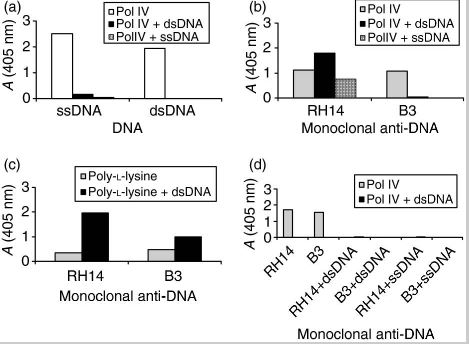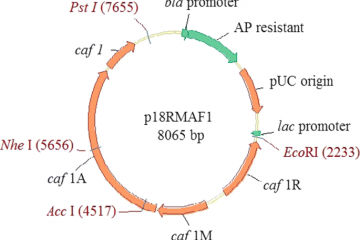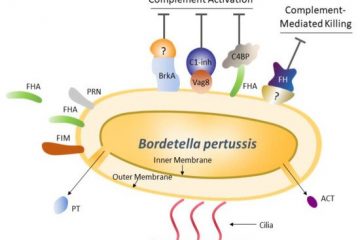ABSTRACT
While immunoglobulin G (IgG) antibodies to double-stranded (ds)DNA are serological markers of systemic lupus erythematosus (SLE), not all antibodies to DNA (anti-DNA) are able to cause tissue damage to a similar extent. It has been proposed that anti-DNA-induced renal damage could be linked to differences in the fine specificity of the antibodies. In an attempt to gain insight into their fine binding properties, we investigated the cross-reactivity of two human lupus monoclonal IgG anti-dsDNA (B3 and RH14) to a recently described Escherichia coli PolIV (a DNA polymerase). These autoantibodies possess distinct pathogenic properties in severe combined immunodeficient (SCID) mice. Although both antibodies cause proteinuria, only RH14 induces early histological features of lupus nephritis. Both RH14 and B3 bound PolIV; however, they exhibited a marked difference in their reactivity to the PolIV–dsDNA complex. Alhough RH14 exhibited significant activity to the complex, the binding of B3 to PolIV complexed with dsDNA was almost abolished. Furthermore, there was a significant difference in the way the lupus sera recognized naked dsDNA and that presented on PolIV. Although 67% of lupus sera bound naked dsDNA, ≈ 90% of these sera (93% calf thymus DNA; 90% synthetic oligonucleotide) reacted to the complex when dsDNA was presented on PolIV. Thus, the IgG anti-dsDNA likely to exist in lupus patients may be distinguished into those that recognize dsDNA in the context of PolIV and those which do not. This difference in binding ability may help to distinguish those dsDNA antibodies that are more pathogenic.

Lupus autoantibodies
Introduction
Systemic lupus erythematosus (SLE) is a severe disease that involves dysregulation of the immune system, excessive production of pathogenic autoantibodies (and their upregulation in serum), and multiple immune-system-mediated injuries. Anti-double-stranded (ds)DNA antibodies have been some of the classic diagnostic and nosological criteria of SLE since 1982. In 2012, the high titer of anti-dsDNA antibodies in serum accompanied by biopsy-proven lupus nephritis (LN) was accepted as an independent classification criterion for SLE by the Systemic Lupus International Collaborating Clinics (1).
However, the wide spectrum of molecular antibody specificity and complex contexts of antibody generation, as well as the diverse antigen structures to which these antibodies bind, make anti-dsDNA antibodies difficult to accept without further distinction as a classification criterion for SLE (1). Pathogenic anti-dsDNA autoantibodies react with DNA but are not strictly specific to it.
DNA fragments
Mouse DNA was prepared from spleen, and E.coli DNA from DH5α using Qiagen DNeasy Blood & Tissue Kit, and digested with DdeI to yield fragments ranging from 0.2–2 kb. The dsDNA fragments CGneg, CG50, Sumo, Senp1, and clone 11 and have been previously described [7, 8]. These fragments as well as unselected mouse DNA and E. coli DNA were biotinylated by filling-in 5’ overhangs from restriction digestion with Klenow(exo-) in the presence of biotin-16-2′-deoxy-uridine-5′-triphosphate [7]. Primers and enzymes were removed from all DNAs using the DNA Clean & Concentrator-25 kit (Zymoresearch). All DNAs contained less than 0.1 EU/ml endotoxin when tested at 5× concentration.
[Linking template=”default” type=”products” search=”native DNA” header=”2″ limit=”20″ start=”2″ showCatalogNumber=”true” showSize=”true” showSupplier=”true” showPrice=”true” showDescription=”true” showAdditionalInformation=”true” showImage=”true” showSchemaMarkup=”true” imageWidth=”” imageHeight=””]


